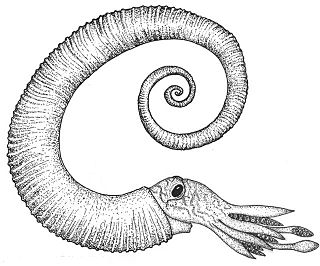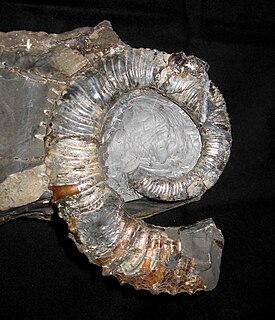
Australiceras is an extinct ammonite genus from the upper part of the Early Cretaceous, Aptian stage, included in the family Ancyloceratidae.

Aegocrioceras is an extinct ammonite genus of cephalopod from the Lower Cretaceous included in the Ammonitida. It is known from northern Europe.
Ammonitoceras is an extinct genus of cephalopod belonging to the ammonite subclass that lived during the latter part of the Early Cretaceous in what is now Europe and the transcaspian region. Ammonitoceras was named by Dumas, 1876, the type-species: Ammonitoceras ucetiae. Although the description doesn't mention a hook, as in Ancyloceras or Acrioceras, Ammonitoceras is included in the Ancyloceratidae. However neither do Australiceras or Tropaeum, which are also included.
Astiericeras is an ammonite from the Lower Cretaceous, the shell of which is evolute, stout; outer whorl with strong, well spaced, transverse ribs that cross smoothly over the broad venter; early whorls with lateral tubercles. The outer, mature whorl separates from the coil but hooks back quickly, referred to as a heteromorph.
Anisoceras is a heteromorph ammonite belonging to the turrilitoid family Anisoceratidae. The shell forms a loose open helical spiral in the early stages, ending in one or two straight shafts in the mature adult. Surface ornament consists of prominent rounded nodes on the lower and upper flanks, connected by strong looped ribs. The nodes may have been the bases of long sharp spines.
Uhligia is a genus of Lower Cretaceous (Barremian) ancylocerid ammonoid cephalopods initially found in Germany.

Ceratitida is an order that contains almost all ammonoid cephalopod genera from the Triassic as well as ancestral forms from the Upper Permian, the exception being the phylloceratids which gave rise to the great diversity of post Triassic ammonites.
Anisoceratidae is an extinct family of heteromorph ammonites which belong to the Ancyloceratina superfamily Turrilitoidea. Members of the family range is from the lower Albian to the upper Turonian. The family is possibly derived from a member of the Hamitidae.

Ammonitina comprises a diverse suborder of ammonite cephalopods that lived during the Jurassic and Cretaceous periods of the Mesozoic Era. They are excellent index fossils, and it is often possible to link the rock layer in which they are found to specific geological time periods.

Turrilitoidea is a diverse superfamily of Cretaceous ammonites generally considered as heteromorphic and commonly included in the suborder Ancyloceratina. Shells of this diverse group do not coil planospirally, as typical for most ammonites, but rather take on a variety of unique forms. Separation of Turrilitoidea along with Ptychoceratoidea and Scaphatoidea into a different suborder, Turrilitina, was proposed by Beznosov and Mikhailova in 1983 however this view is not accepted by most authors.

Nipponites is an extinct genus of heteromorph ammonites. The shells of Nipponites form "ox-bow" bends, resulting in some of the most bizarre shapes seen among ammonites.

Exiteloceras is an ammonite genus from the Late Cretaceous.

Nostoceras is an extinct genus of ammonites. The etymology of the name Nostoceras comes from "nostos" meaning return and "ceros" meaning horn, named as such by Alpheus Hyatt because it bends back on itself.
Heteroceras is a Lower Cretaceous heteromorph ammonite belonging to the ancyloceratoidean family, Heteroceratidae.
Ancyloceratoidea, formerly Ancylocerataceae, is a superfamily of typically uncoiled and loosely coiled heteromorph ammonoids established by Alpheus Hyatt in 1900, that may contain as many as 11 families, depending on the classification accepted.
Pachyceratidae is a family of Perisphinctoidean ammonites from the upper Middle - and lower Upper Jurassic. Genera within the Pachyceratidae have shells that are in general moderately involte but with most of the inner whorls exposed; whorl sections subquadrate to subtrapezoidal, with rounded venter. Ribbing is strong, in some sharp. Primary ribs typically branch above mid flanks into twos, threes, and even fours.
Turrilitina is a proposed suborder of Cretaceous heteromorph ammonoid cephalopods derived from the Lytoceratidae in the Hauterivian stage of the Lower Cretaceous that would include the superfamilies Turrilitoidea, Ptychoceratoidea, and Scaphatoidea.

Ancyloceratidae is a family of heteromorphic ammonites that lived during the Early Cretaceous. Their shells begin as a loose spiral with whorls not touching which then turns into a straight shaft that ends in a J-shape hook or bend at end. Coarse ribbing and spines are common.
The Crioceratidae constitute a family of loosely to closely coiled Ammonitida included in the Ancyloceratoidea that lived during the Early Cretaceous; characterized by Crioceratites and other genera such as Hoplocrioceras and Paracrioceras.

Macroscaphitidae is an extinct family of ptychoceratoid cephalopods from the subclass Ammonoidea that lived from the Lower Barremian to the Lower Cenomanian stages of the Cretaceous. Fossils of Macroscaphitidae were found all around the world although the abundance of found fossils is rather limited. Known fossils from collections were found largely in Europe, South America and Africa. It is known for some species of which complete specimens were found that these animals developed a hetermorphic shell, i.e. the coiling of the shell was not regular, such that the first whirls formed a planispirally coiled evolute section as seen in homomorphic ammonites, but had an additional straight middle part and a presumably upwards facing aperture. Due to their odd morphology the taxonomic classification of Macroscaphitidae changed often over time since their discovery and may not be finally settled even now.









